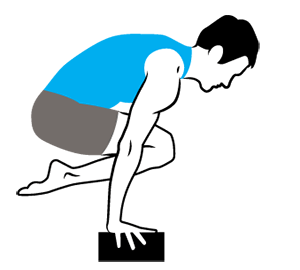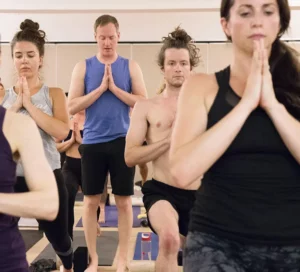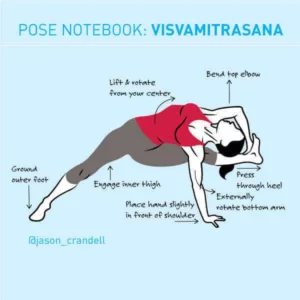Fear can feel painful, overwhelming, even paralyzing. Whether you’re facing a major life change like an illness or a break-up, or a more specific fear like giving a presentation to colleagues or standing in front a group and teaching a yoga class, I hope this post gives you some idea for navigating fear with more ease.
I’m not going to lie. I still have moments, hours, or even days when I’m consumed with fear about cancer. Despite the campaigns that have played out over the past 20 years, early detection does not guarantee a cure for breast cancer. (Laurie Becklund, a well-known reporter for the LA Times, faced this reality and wrote about it just before she died from metastatic breast cancer in March.)
I never used to be afraid to go to the doctor. But that’s different now. My fear arises with a vengeance when it’s time for a check-up. There are lots of them at this point. For all kinds of whacked out lady-related things that I won’t go into here. (You’re welcome.)
Last week, before one of these check-ups, I spent 24 hours moving through what I am now referring to as my Seven Stages of Coping with Fear. I am now intimately familiar with these stages because last fall they were on a repeat loop while I was constantly awaiting test results. This means that I:
1. Feel completely disconnected from my current reality and feign normal interactions with my loved ones while my mind works up as many worst-case scenarios as it can muster.
2. Google these worst case scenarios while pretending to watch The Amazing Race with my husband until my thumbs go numb.
3. Practice yoga. Moving the energy does make me feel better and it gets me out of my head. For a short period of time. But if the fear is great enough, it rears its ugly head again.
4. Feel nauseated. Which means that I either can’t eat or all I want to eat is chocolate and potatoes.
5. Blast Megan Trainor and dance around the living room. (This makes my poor husband feel nauseated.)
6. When all of those things don’t work….I cry. These days I try to cry when my husband is around because I know that nothing good comes from crying about cancer when I’m all by myself.
7. Finally, I do what my yoga teacher friend Deb Burkman (who also happens to be a breast cancer survivor) advised after I pleaded via email last year to share how she got through the diagnosis phase. Her answer was simple: She said she remembers what the Dalai Lama once said, which is that he tries to make friends with the fear. This sage bit of wisdom has helped me tremendously.
You see, most of the time when we feel fearful, we instinctively take some helpful action to mitigate the fear. But…what do you do when you can’t take action to make things better? When you can’t just take control of the situation? In my situation, the question is, how do I “sit” with the fear of facing my mortality head on?
It’s times like these when we’re really called upon to do yoga. We take all of those hours that we’ve logged on our mats—breathing and moving, watching and responding—and put them into practice. The technique of making friends with fear has served as a little bridge to help me do that.
Here’s the internal map of why it helps me so much: For starters, it puts me in the role of observer, or what’s known in yoga as witness consciousness. I can see the fear as a separate entity from me and observe it, just like I watch my body during asana practice. I can see that it has an energy just like all my other emotions have different energies and effects. And I can witness how it’s causing me some pain. But I don’t have to be sucked into the loud screaming drama of fear just like I don’t have to put all of my focus and attention on the most difficult aspect of a pose. I can stand back and watch myself move through the challenging experience, whether physical or mental.
From that place of witnessing, I can start making friends with fear by acknowledging that it exists. The simple act of acknowledgment immediately defuses some of fear’s power. Instead of bracing myself and pushing against fear with my full body weight, I can stand and greet it eye to eye.
From acknowledgment comes acceptance. I allow the fear to be there. I don’t have to feel guilty or weak for my vulnerabilities. I don’t have to “warrior up” and conquer my fear. Fear is allowed to have its place in my consciousness from time to time. It’s allowed a seat at the table. I may not like the way it feels, but I can allow it to be there. And once I do that, I realize that I can handle it. Fear is not going to suffocate or drown me.
At this point – and this is the best part — I’m able to soften – inside and out. When I see fear as a something that I can make friends with, the energy of the emotion subsides a bit. It loosens its noose-like grip around my neck. My shoulders relax. My breath deepens. The fear itself is not so scary and angry and strange. It’s no longer an adversary, a scary black cat skulking around behind me – it’s actually quite sweet and scared and timid and normal. And I can feel that it needs what I need as I’m going through all of this – some love, some attention. A hug. A deep breath. A pat on the back. It needs some comfort. It knows that it’s got a crappy role in life, but it’s just doing its job, right?
When I soften, I’m in the true yoga space again. I’m present with the current reality – which is that I’m well. I’m not living in a hospital. And none of us knows how long we will live.
Now, I’m armed with a technique for when fear visits me again. I can repeat the inner mantra, “witness, acknowledge, allow, soften.” And you can, too. I hope it helps you with whatever fear you’re facing right now.



